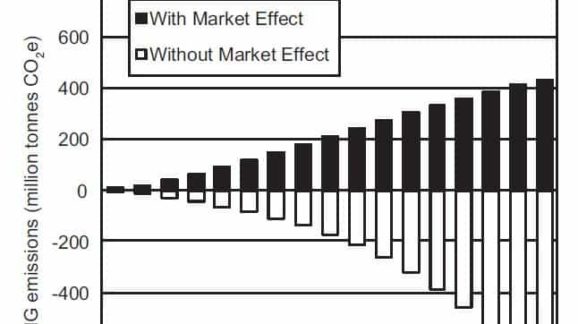Does EPA’s Renewable Fuel Standard Increase Greenhouse Gas Emissions?

A new University of Minnesota study finds that the Renewable Fuel Standard (RFS2) program leads to net increases in greenhouse gas (GHG) emissions. No, this is not another study purporting to show that the life-cycle (wells-to-wheels) carbon-intensity of corn ethanol is greater than that of the gasoline it replaces.
For purposes of this analysis, the researchers assume that the Environmental Protection Agency correctly estimates the life-cycle carbon intensities of RFS2-compliant biofuels as being lower than gasoline by 20 percent (conventional biofuels), 50 percent (advanced biofuels), and 60 percent (cellulosic biofuels). Nonetheless, they conclude that the federal mandate to produce less GHG-intense fuels “actually increases net GHG emissions to the atmosphere.”
Two factors drive this paradoxical result. The first is the “market rebound effect.” By expanding biofuel production, RFS2 increases the overall supply of motor fuel. “In general, an increase in fuel supply causes a decrease in fuel prices, which in turn encourages greater fuel consumption.”
The second factor, which is a consequence of the first, is that each gallon of biofuel introduced into commerce displaces less than one gallon of gasoline. Citing the academic literature, the researchers assume a “conservative gasoline displacement rate of 0.50”—in other words, each gallon of biofuel displaces half a gallon of gasoline.
Biofuel mandates will reduce net GHG emissions only if “the savings from the reduction in carbon intensity outweighs the increase in GHG emissions from additional fuel use.” But the opposite occurs under RFS2. The increase in GHG emissions from additional fuel outweighs the carbon-intensity reduction from substituting biofuels for gasoline.
Here’s the bottom line. If, as EPA assumes, there is no fuel market rebound effect and each gallon of biofuel reduces gasoline production by one gallon, “RFS2 would reduce GHG emissions by 110 million metric tons (CO2 equivalent) in 2022, and by 749 million metric tons cumulatively from 2006 to 2022.” But if, as the economics literature suggests, there is a fuel market rebound effect, “RFS2 actually leads to a net increase in GHG emissions of 22 million metric tons in 2022, and of 431 million metric tons cumulatively from 2006 to 2022.”
The figure below shows how the market rebound effect turns EPA’s estimated emission reductions (white bars) into emission increases (black bars).
“Only cellulosic biofuels with a carbon intensity 60 percent lower than that of gasoline reduces net GHG emissions,” the researchers estimate. Cellulosic biofuel, however, is the least economic type of renewable motor fuel. As Howard Gruenspecht of the Energy Information Administration recently testified:
The premise that advanced biofuels, particularly liquid cellulosic biofuels, would be available in significant quantities at reasonable costs within 5 to 10 years following adoption of the 2007 RFS targets has not been borne out. The supply of liquid cellulosic fuels (including primarily cellulosic ethanol and renewable fuel oil) in 2015 was 2.6 million ethanol-equivalent gallons, less than 0.1 percent of the 3 billion ethanol-equivalent gallon legislated target for that year.
The Minnesota study’s concluding section acknowledges the concern that biofuel mandates may also increase overall GHG emissions by encouraging farmers to convert forests and grasslands to croplands. “As a result, it is unclear whether some biofuels, in particular corn ethanol, actually reduce GHG emissions, even absent consideration of the fuel market rebound effect (National Research Council, 2011).”